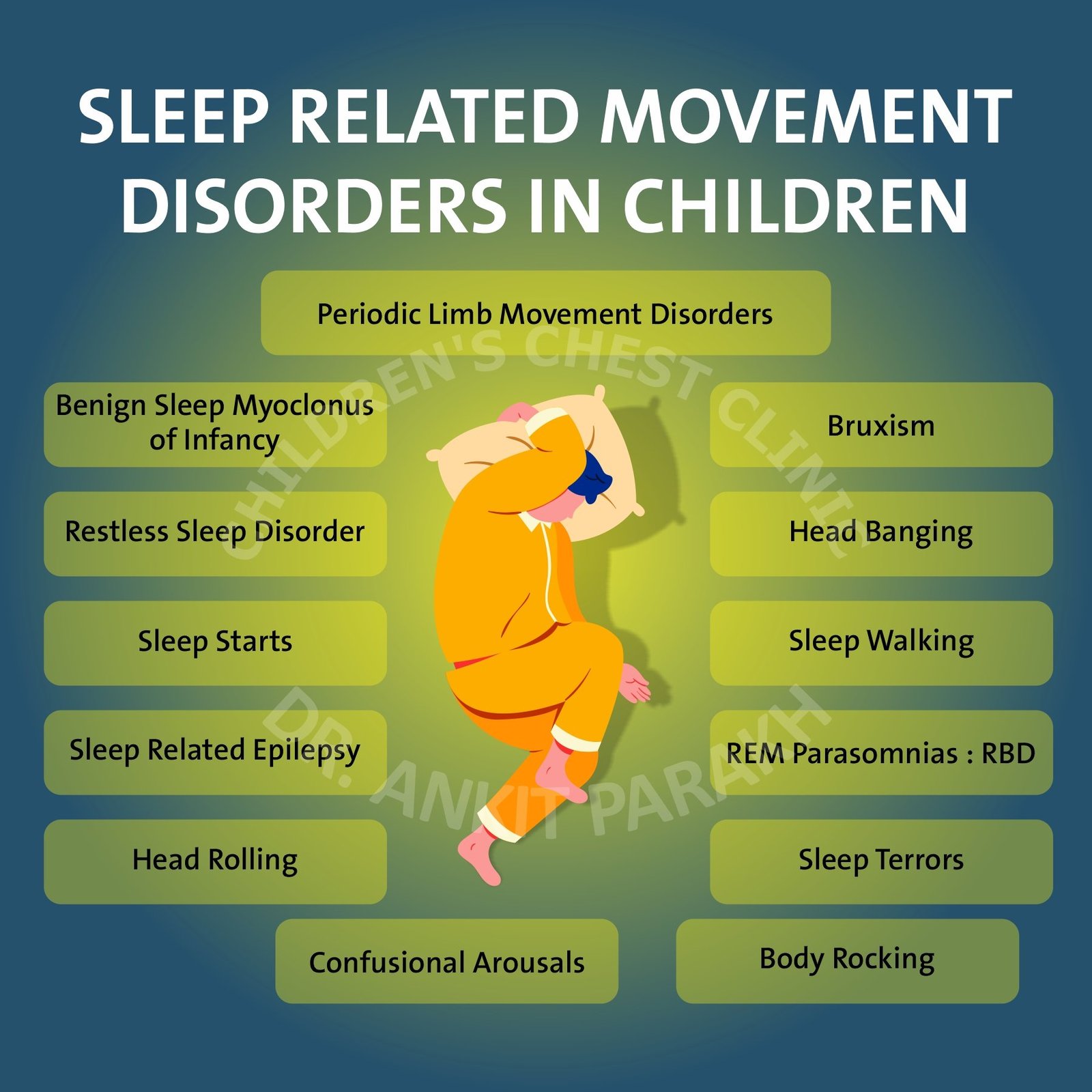
Sleep-Related Movement Disorders in Children
Sleep is essential for a child’s growth and well-being, but when movement disorders disrupt rest, the consequences can be significant. Sleep-related movement disorders include a group of conditions where involuntary movements interfere with sleep. Among these, Restless Legs Syndrome (RLS) and Bruxism are the most recognized. This section delves into the causes, symptoms, investigations, and treatments of these conditions to help parents understand and manage them effectively.
What is Restless Legs Syndrome (RLS) in Children?
Restless Legs Syndrome (RLS) is a neurological condition characterized by an irresistible urge to move the legs, usually accompanied by uncomfortable sensations. These symptoms occur predominantly during the evening or at night, disrupting sleep.
Causes of Restless Legs Syndrome in Children
Genetic Factors:
- RLS often runs in families, suggesting a strong genetic component.
Iron Deficiency:
- Low iron levels or iron metabolism issues in the brain are commonly linked to RLS.
Neurological Conditions:
- Conditions like ADHD may increase the likelihood of RLS.
Dietary or Medical Issues:
- Certain deficiencies, including folate or magnesium, and chronic conditions like kidney disease can contribute to RLS.
Symptoms of RLS in Children
- Restless leg syndrome is an urge to move the legs that is usually, but not always, accompanied or caused by uncomfortable and unpleasant leg sensations. The symptoms only occur or are worse in the evening or night than during the day.
- The symptoms begin or worsen during rest or inactivity and symptoms are partially or totally relieved by movements such as walking or stretching for at least as long as the activity continues.
- Difficulty falling asleep or staying asleep and poor-quality sleep.
What is Bruxism in Children?
Bruxism is the repetitive grinding or clenching of teeth during sleep. While it may seem harmless, prolonged Bruxism can lead to dental issues and disrupted sleep.
Causes of Restless Legs Syndrome in Children
Stress or Anxiety:
- Emotional stress or underlying anxiety can lead to Bruxism.
Sleep Disorders:
- Conditions like obstructive sleep apnea may coexist with Bruxism.
Dental Misalignment:
- Irregular alignment of teeth can increase the likelihood of teeth grinding.
Neurological Factors:
- Hyperactivity or certain neurological conditions may trigger Bruxism.
Symptoms of Bruxism in Children
- Grinding sounds during sleep, audible to parents or siblings.
- Jaw pain or discomfort upon waking.
- Worn-down or damaged teeth.
- Sleep disturbances or morning headaches.
Investigating Sleep-Related Movement Disorders in Children
Proper diagnosis is key to addressing RLS and Bruxism. Here’s how these conditions are typically investigated:
- Detailed Sleep History: A comprehensive account of the child’s sleep patterns, symptoms, and medical history.
- Iron and Nutritional Studies: Blood tests to check iron levels, as deficiencies are common in RLS.
- Polysomnography (Sleep Study): This overnight test can assess involuntary leg movements (Periodic Limb Movements of Sleep) and Bruxism, along with any coexisting sleep disorders.
- Dental Examination: Evaluation of teeth and jaw alignment for signs of Bruxism.
- Psychological Assessment: Identifying stressors or anxiety contributing to Bruxism or RLS.
Treatment for Restless Legs Syndrome and Bruxism in Children
Iron Supplementation:
- Correcting iron deficiency through diet or supplements.
Lifestyle Modifications:
- Encouraging regular exercise and maintaining a consistent sleep schedule.
- Limiting caffeine and sugary foods before bedtime.
Massage and Warm Compresses:
- These can help alleviate discomfort in the legs before sleep.
Medications (in Severe Cases):
- A pediatrician may consider medications like dopamine agonists, though this is rare in children.
Bruxism:
- Stress Management: Techniques like relaxation exercises, yoga, or counseling can help reduce stress.
- Mouth Guards or Splints: Custom-fitted dental devices can protect teeth from grinding damage.
- Addressing Underlying Sleep Disorders: Treating conditions like obstructive sleep apnea can improve Bruxism.
- Parental Guidance: Parents can help monitor and address triggers, such as bedtime routines or emotional stress.
Restless Legs Syndrome (RLS) and Bruxism are common but manageable sleep-related movement disorders in children. Early identification and tailored treatment can significantly improve a child’s sleep quality and overall well-being. If you suspect your child has RLS or Bruxism, consult a pediatric sleep specialist or dentist for a comprehensive evaluation and treatment plan.
Conclusion
Sleep Disorders in children
Frequently Asked Questions (FAQs)
1. What are the key signs of Restless Legs Syndrome in children?
Symptoms include an urge to move the legs, worsening at night, and difficulty falling asleep or staying asleep.
2. Is Bruxism harmful to children’s teeth?
Yes, prolonged Bruxism can lead to worn-down teeth, jaw pain, and dental issues if left untreated.
3. How is RLS treated in children?
Treatment focuses on correcting iron deficiencies, lifestyle changes, and, in rare cases, medications under medical supervision.
4. Can stress cause Bruxism in children?
Yes, emotional stress or anxiety is one of the leading causes of Bruxism in children.
5. What is the role of a sleep study in diagnosing RLS or Bruxism?
A sleep study can detect involuntary movements, teeth grinding, and other coexisting sleep disorders to aid in diagnosis.



